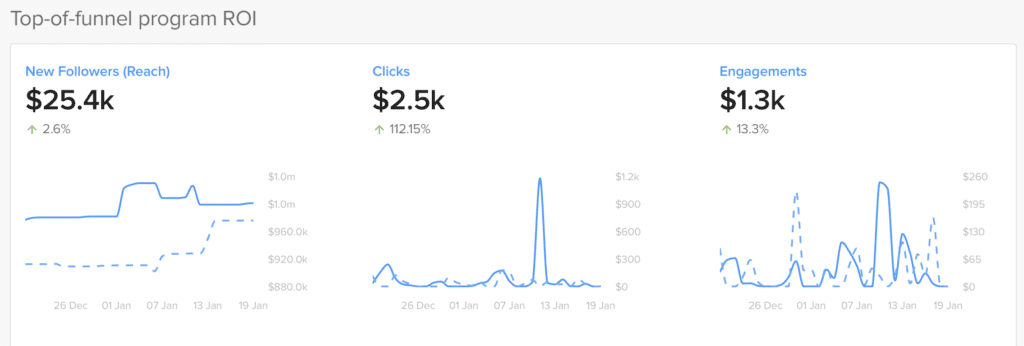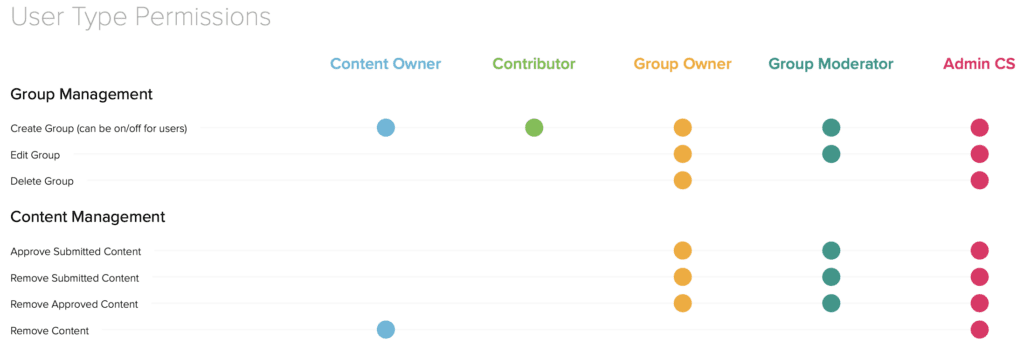What do Qualtrics, Unity, Instructure, and American Family Insurance all have in common?
In addition to being leaders in their respective industries, they also all boast active employee social-sharing programs with incredible ROI.
Although these companies vary in size and provide very different products and services, they all reap the benefits of employee advocacy because they understand there’s more to their programs’ success than just employee access to social media or a top-notch advocacy solution. (And they certainly have the latter — they’re all EveryoneSocial customers.)
They set their employees and their social-sharing programs up to be winners by providing these eight must-haves for advocacy success. Let’s dive in.
1. Relevant Content Users Actually Want to Share
Content is at the core of a successful employee social-sharing program, and we’re not just talking about company content like blog posts and press releases.
Employees need access to a variety of relevant, easy-to-share content that’s not entirely branded or corporate.
Why?
- Because if you want employees to share content, they actually have to want to share it. That means the content has to interest them and serve them.
- Because it screams inauthenticity if employees’ personal social accounts read exactly like your corporate handles’. (Employees sounding like corporate shills is just one reason to avoid automatic sharing.)
“Put yourself in employees’ shoes and think about what content makes sense for your users,” says Cameron Yates, EveryoneSocial’s senior sales engineer and enablement lead.
“That’s not just company news and blog posts, but also industry news, professional development information, and more. If employees log in to your advocacy platform and see only company content, it’s going to be very obvious to them that this program’s more about benefiting the company and achieving marketing goals than it is about benefiting them as professionals.”
Of course, the same content is going to appeal to every employee or be suitable for them. That’s why EveryoneSocial has a private groups feature.
While everyone can have access to and benefit from company updates, employee-generated content, and the latest meme the social media manager created, other content may be better suited for people with specific interests, certifications, or positions. That’s why many of our customers set up private groups for executives or the engineering team, for example.
“It’s all about what your users are into,” says Kaityn Riddle, Infoblox’s global social media marketing manager. “If they’re into tech news, set up a tech news content group or have your users set those up. It really comes down to figuring out what your users are interested in and what they want to share content about.”
2. Participation All the Way at the Top
You can’t expect people to participate in your employee social-sharing program if the organization’s leaders aren’t. That’s why executive buy-in and involvement is critical to employee advocacy.
“Leadership is hypercritical,” Yates says. “There needs to be a culture of social activity being accepted and encouraged. And for employees to be comfortable doing this, it needs to start at the very top.”
No one understands this better than American Family Insurance whose CEO, Jack Salzwedel, is one of the most active and engaged CEOs on Twitter.
“It’s our goal to empower our people to find their voices — something that starts with our CEO,” says Tom Buchheim, who leads AmFam’s employee advocacy initiative.
With Salzwedel at the social media helm, AmFam’s employee social-sharing program has flourished.
But that’s not the only upside of C-Suite participation — check out the other benefits your organization will reap.
3. A Culture that Fosters Social Sharing
If you want employees to share company content and post about the organization — especially if you want them to post positive things — you need to create a work environment that inspires this kind of action.
Employees need to feel psychologically safe and empowered so they’re comfortable expressing their thoughts and opinions. A company culture that achieves this is the kind of environment that people will want to tell their networks about, which benefits your employer brand.
Plus, companies with great cultures are places people want to work, while 86% of job seekers avoid organizations with a bad reputation.
Not sure if your company culture measures up? Solicit employee feedback, conduct regular engagement surveys, practice social listening, and audit reviews from employees on sites like Glassdoor.
If there’s room for improvement, it’s time to take steps to improve your culture.
4. Measurable Goals to Assess Success
Before you launch an employee social-sharing program, determine what you want to get out of it and set clear, specific goals.
There are numerous benefits to employee advocacy — from increasing social reach and engagement to increasing the sales pipeline and driving up to 48% larger deals.
Select KPIs that reflect your goals and regularly assess them to determine what’s working and what’s not to ensure you get the most out of your advocacy initiatives.

EveryoneSocial’s easy-to-use analytics dashboard makes it a breeze to check KPIs like clicks, reach, and engagement at a glance.
5. A Pure Play Social-Sharing Platform
If you really want to ensure your employee social-sharing program’s success, you need to invest in a solution designed to get employees creating, engaging, and sharing.
There are numerous so-called advocacy tools on the market, but many are actually just social media tools that have secondary advocacy features.
What should you look for in a true advocacy solution? Check out this comprehensive guide.
Not sure how to pay for it? Here’s how to budget for an employee advocacy platform.
6. Dedicated Admins and Moderators
An advocacy tool alone isn’t enough to ensure your advocacy efforts will pay off — expecting the program to run itself is a common pitfall.
Once your social-sharing software is set up and ready to go, you need ongoing support not only externally from a top-notch customer success team (By the way, EveryoneSocial has that!), but also internally in the form of administrators and moderators.
In EveryoneSocial, for example, admins can create and manage groups, approve and remove content, create share copy, manage posts, and more.
Moderators, on the other hand, can create groups, approve content, and create suggested copy for users.
“The idea with moderators is that they are a user class that sits between your normal user and your admin,” says EveryoneSocial CEO Cameron Brain. “They’re super helpful for keeping people’s feeds populated with relevant, fresh content.”

These roles don’t only ensure that users’ feeds are full of quality content to share, but they also help your social-sharing program run smoothly by ensuring employees know who to turn to with any questions.
7. Power Users to Lead the Way
Ninety-eight percent of employees use at least one social network, and 50% already post about their company, so your organization is no doubt home to employee influencers. You just need to identify them.
These are going to be your power users, and they’re the people you want to get on board with your social-sharing program from day one.
“Power users are really your most important user demographic because they are the ones who are keeping that flywheel moving,” Brain says. “They show what’s possible, and others learn from them, so they both drive external results and internal engagement and participation.”
You can determine who your employee influencers are through a survey or by using social listening to assess what your people already post about the company.
8. Guidelines and Training to Empower Users to Share
The best employee social-sharing programs provide their people with all the tools they need to effectively use social media.
These include a social media policy to both protect the company and encourage employees to post, as well as social media training.
These are key to your program’s success, yet organizations often fail to provide either one.
In fact, only half of workers say their companies have social media rules in place, and 75% of them haven’t received any instruction on how to engage professionally online. Yikes.
Don’t just ask your people to post and engage online without any guidance. Set them up for success by explaining how your advocacy initiatives benefit them by helping them expand their networks, improve their skills, develop their personal brands, and more. And take the time to go over your social media policy and train your people.
Need some help getting started? Check out this post on how to create simple social media rules for employees.
The Social-Sharing Platform You Need
Now that you understand what your employee social-sharing program needs, are you ready to launch your initiative with the best advocacy platform on the market?
If so, start using EveryoneSocial today for free!
















